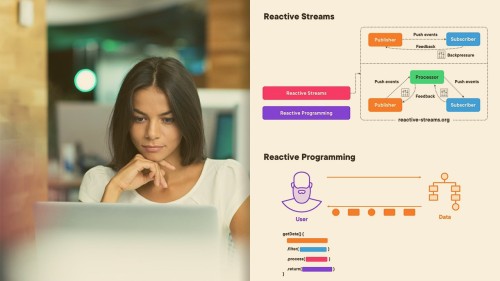
 |
Reactive Applications with Spring WebFlux Framework
 Reactive Applications with Spring WebFlux Framework Published 12/2024 Created by Sergey Kargopolov MP4 | Video: h264, 1280x720 | Audio: AAC, 44.1 KHz, 2 Ch Level: All | Genre: eLearning | Language: English | Duration: 91 Lectures ( 7h 7m ) | Size: 2.53 GB Creating a Secure, Reactive and non-blocking REST API with Spring WebFlux What you'll learn What Reactive Programming is Architecture of Reactive Spring Boot application Create Reactive Spring Boot application Write and read from a database in reactive/non-blocking way Use Spring Security in reactive Spring WebFlux application Implement user authentication in reactive application Implement JWT authentication in reactive application Create and validate JSON Web Tokens(JWT) Use method-level security annotations Write Spring Security Expressions(SpEL) Requirements Basic knowledge of Java Basic familiarity with Spring Framework Description In this video course you will learn how to create Reactive and Non-blocking applications with Spring WebFlux framework. This course is perfect for beginners and will start with the basics of Spring WebFlux.You will learn: - What Reactive programming is and how it is different from an imperative programming style, - The key differences between the traditional, blocking Spring WebMVC and the non-blocking, Reactive Spring WebFlux applications,- To create reactive RESTful Web Service application that handles different types of HTTP requests, - Write and read information from a database in a reactive, non-blocking way.As you progress through the course, you will learn how to: - Use Spring Security to protect your Spring WebFlux application, - Implement user login(authentication), - Generate and use JSON Web Tokens (JWT) for secure communication- Validate JWT and read token claims, - Use method-level security annotations to perform authorization. You will also learn how to add pagination and read database records in smaller chunks to improve performance.All important concepts are explained using simple, easy-to-follow slides. The source code is provided, so you can download it and follow along with each lesson.This course also includes helpful quiz questions to test your knowledge as you go. Plus, there is an active Q&A section where you can get answers to all your questionsBy the end of this course, you'll be able to create fast, secure, and scalable Reactive applications with Spring WebFlux. Who this course is for Java developers interested in learning how to create reactive applications with Spring Framework Homepage Цитата:
|
| Часовой пояс GMT +3, время: 17:03. |
vBulletin® Version 3.6.8.
Copyright ©2000 - 2025, Jelsoft Enterprises Ltd.
Перевод: zCarot